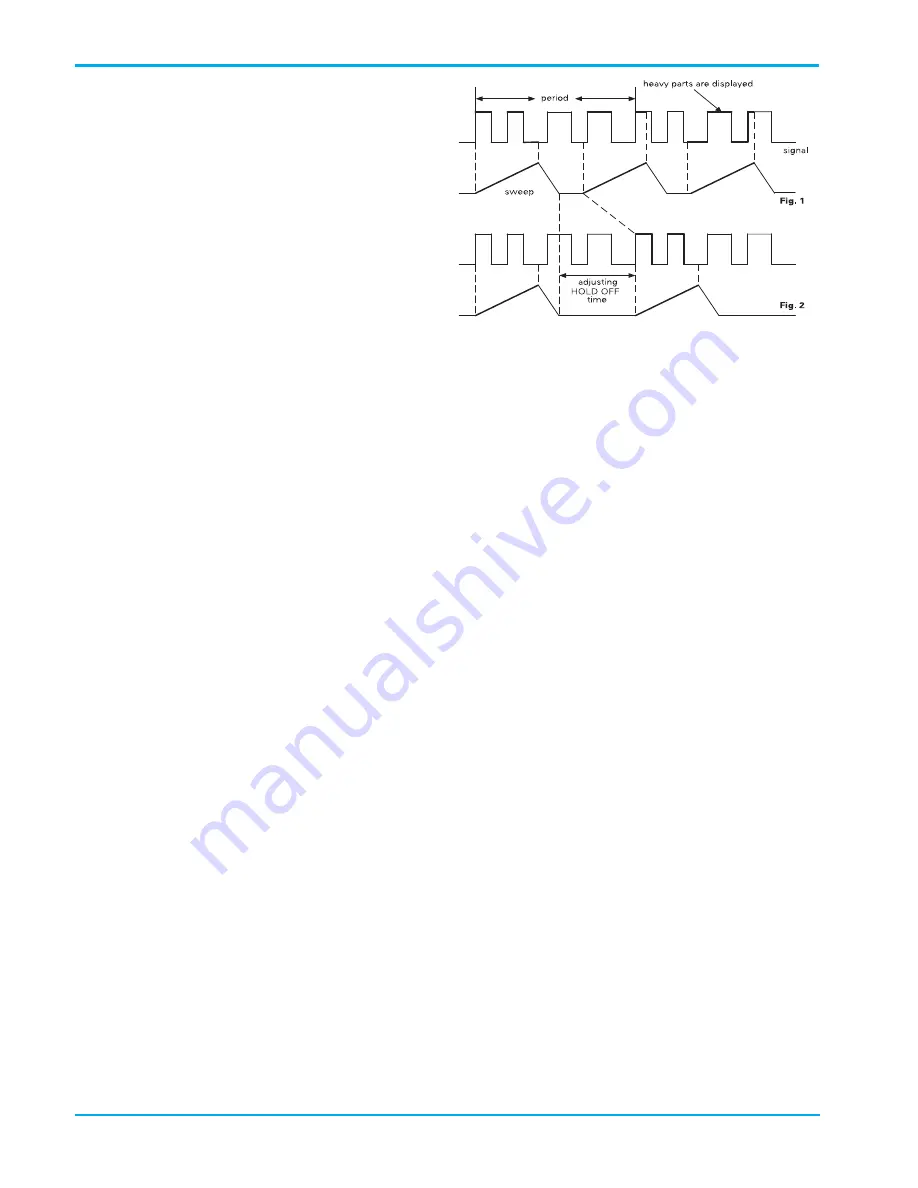
Subject to change without notice
30
form from the test signal voltage, but must be synchronous with
the test signal. Triggering is even possible in certain limits with
whole number multiples or fractions of the test frequency.
It must be noted that a different phase angle between the
measuring and the triggering signal may cause a display not
coinciding with the slope selection setting.
The trigger coupling selection can also be used in external
triggering mode.
Trigger indicator ”TR”
The following description applies to the
”TR” LED
.
Please note
item
[10]
under ”Controls and Readout”.
An LED on condition indicates that the trigger signal has a
sufficient amplitude and the trigger level control setting is correct.
This is valid with automatic and with normal triggering. By
observing the trigger LED, sensitive trigger level adjustment is
possible when normal triggering is used, particularly at very low
signal frequencies. The indication pulses are of only 100ms
duration. Thus for fast signals the LED appears to glow
continuously, for low repetition rate signals, the LED flashes at
the repetition rate or at a display of several signal periods not only
at the start of the sweep at the left screen edge, but also at each
signal period.
In automatic triggering mode the sweep generator starts
repeatedly without test signal or external trigger voltage. If the
trigger signal frequency decreases the sweep generator starts
without awaiting the trigger pulse. This causes an untriggered
display and a flashing trigger LED.
HOLDOFF time adjustment
For instrument specific information please note DEL.POS. / HO
LED
[21]
in section ”Controls and Readout”.
If it is found that a trigger point cannot be found on extremely
complex signals, even after careful adjustment of the trigger level
control, a stable display may often be obtained using the holdoff
control. This facility varies the holdoff time between two sweep
periods approx. up to the ratio 10:1. Pulses or other signal
waveforms appearing during this off period cannot trigger the
time base.
Particularly with burst signals or aperiodic pulse trains of the
same amplitude, the start of the sweep can be delayed until the
optimum or required time.
A very noisy signal or a signal with a higher interfering frequency
is at times displayed double. It is possible that trigger level
adjustment only controls the mutual phase shift, but not the
double display. The stable single display of the signal, required for
evaluation, is easily obtainable by expanding the holdoff time until
one signal is displayed.
A double display is possible with certain pulse signals, where the
pulses alternately show a small difference of the peak amplitudes.
Only a very exact trigger level adjustment makes a single display
possible. The use of the holdoff control simplifies the right
adjustment.
After specific use the holdoff control should be reset into its
calibration detent (fully ccw), otherwise the brightness of the
display may be reduced drastically. The function is shown in the
following figures.
Fig. 1 shows a case where the holdoff control is in the minimum
position and various different waveforms are overlapped on the
screen, making the signal observation unsuccessful.
Fig. 2 shows a case where only the desired parts of the signal are
stably displayed.
Delay / After Delay Triggering
The instrument specific information regarding this mode is part of
the section ”Controls and Readout” paragraph DEL.POS. / HO
LED
[21]
and DEL.MODE / ON OFF
[23]
.
As mentioned before, triggering starts the time base sweep and
unblanks the beam. After the maximum X deflection to the right,
the beam is blanked and flies back to the (left) start position. After
the holdoff period the sweep is started automatically by the
automatic trigger or the next trigger signal. In normal triggering
mode the automatic trigger is switched off and will only start on
receipt of a trigger signal.
As the trigger point is always at the trace start position, trace
expansion in X direction with the aid of the time base is limited to
the display on the left of the trace. Parts of the signal to be
expanded which are displayed near the trace end (right side of the
screen) are lost when the time base speed is increased (time
coefficient reduced).
The delay function delays the trace start by a variable time from
the trigger point. This allows the sweep to begin on any portion
of a signal. The time base speed can then be increased to expand
the display in X direction. With higher expansion rates, the
intensity reduces and within certain limits this can be compensated
by a higher intensity
(INTENS)
setting.
If the display shows jitter, it is possible to select for (second)
triggering after the elapsed delay time
(“dTr”)
. As mentioned
before, it is possible to display video signals using the frame sync
pulses for triggering
(TVF)
. After the delay time set by the
operator, the next line sync pulse or the line content may be used
for triggering. So data lines and test lines can be displayed
separately.
Operation of the delay function is relatively simple. Without delay
function set the time coefficient setting
(TIME/DIV)
until 1 to 3
signal periods are displayed. Display of less than two periods
should be avoided as it limits the selection of the signal section
to be expanded.
The
X MAG (x10)
function should be switched off in the beginning
but may be activated later. The signal must be triggered and
stable.
Triggering and time base
Summary of Contents for HM504-2
Page 2: ......
Page 3: ...O s c i l l o s c o p e H M 5 0 4 2 Manual English...
Page 39: ...37 Subject to change without notice Front Panel HM504 2...
Page 40: ......
Page 41: ...LEER...











































